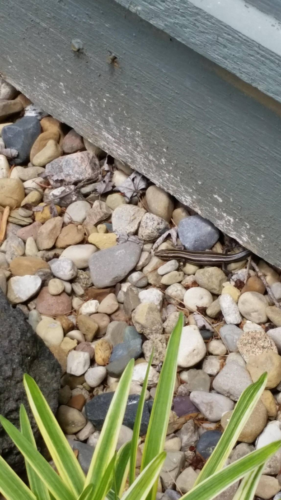 Purdue University - Extension - Forestry and Natural Resources
Purdue University - Extension - Forestry and Natural Resources
Got Nature? Blog
Question: This little guy lives around our house. We see him almost daily. Do you know what he is? Salamander? Skink? Lizard?
The animal pictured is both a lizard and a skink – specifically, a Common Five-lined Skink. More than 1,200 species of skinks are distributed worldwide. Most are medium-sized lizards with body lengths typically ranging 4-12 centimeters. Skinks are active and alert lizards covered with smooth overlapping scales on the sides and back.

Common Five-lined Skinks are usually 5-7 centimeters in body length(12-21 cm total length) and have smooth overlapping scales. Their heads are distinct from their necks and ear openings are smaller than the eyes. Physical characteristics of Common Five-lined Skinks vary by sex and age. Juveniles have bright blue tails and shiny black bodies marked with five yellow longitudinal stripes. Adult males are uniformly brown and develop wider heads, with red to orange coloration on the snout and jaws. Very faint stripes also might be visible on some adult males. Adult females have brownish bodies marked with five yellowish to cream longitudinal stripes and sometimes have a hint of bluish tail.
Throughout most of Indiana, Common Five-lined Skinks are a common species of open woodlands and edges where stumps, logs, woody debris, and rock piles are present. Porches and rock cover around homes and driveways offer good habitat for these lizards. Areas like these offer hiding places, areas to bask in the sun, and food. Most activity occurs on or near the ground, although they occasionally will climb trees. Their active season extends from April to October. Five-lined Skinks actively pursue a variety of invertebrates including insects, spiders and millipedes.
Resources:
Snakes and Lizards of Indiana, The Education Store, Purdue Extension’s resource center
How can I tell if a snake is venomous, Purdue Extension-Forestry and Natural Resources
Brian MacGowan, Extension Wildlife Specialist
Department of Forestry & Natural Resources, Purdue University

Recent Posts
- Experience Indiana’s Sandhill Crane Fall Migration
Posted: November 8, 2024 in Forestry, Wildlife - Purdue Extension’s Showcase, Impacting Indiana
Posted: in Community Development, Forestry, Forests and Street Trees, Gardening, Land Use, Natural Resource Planning, Timber Marketing, Urban Forestry, Wildlife, Wood Products/Manufacturing, Woodlands - Deer Season is Here, MyDNR and Wild Bulletin
Posted: in Forestry, Wildlife, Woodlands - ID That Tree: Learn to Identify Hoptree/Wafer Ash
Posted: October 30, 2024 in Forestry, Forests and Street Trees, How To, Urban Forestry, Wildlife - Publication – Handbook on Processing Fish for Small-Scale Fish Farmers
Posted: October 17, 2024 in Aquaculture/Fish, Aquatic/Aquaculture Resources, How To, Publication, Wildlife - When Roundup Isn’t Roundup – Purdue Landscape Report
Posted: in Forestry, Gardening, Plants, Urban Forestry - American Citizen Planner – Indiana Program Celebrating 4 Years of Impact
Posted: October 16, 2024 in Community Development, Land Use - IN DNR Deer Updates – Epizootic Hemorrhagic Disease Detected in Several Areas in Indiana
Posted: in Alert, Disease, Forestry, How To, Wildlife, Woodlands - Black Spot of Elm – Purdue Landscape Report
Posted: October 15, 2024 in Urban Forestry, Wildlife, Woodlands - Economics and Aquaculture Expert Kwamena Quagrainie is Featured Specialist in ANR Newsletter
Posted: in Aquatic/Aquaculture Resources, Great Lakes
Archives
Categories
- Alert
- Aquaculture/Fish
- Aquatic/Aquaculture Resources
- Ask the Expert
- Christmas Trees
- Community Development
- Disease
- Drought
- Forestry
- Forests and Street Trees
- Gardening
- Got Nature for Kids
- Great Lakes
- How To
- Invasive Animal Species
- Invasive Insects
- Invasive Plant Species
- Land Use
- Natural Resource Planning
- Nature of Teaching
- Plants
- Podcasts
- Ponds
- Publication
- Safety
- Spiders
- Timber Marketing
- Uncategorized
- Urban Forestry
- Webinar
- Wildlife
- Wood Products/Manufacturing
- Woodland Management Moment
- Woodlands